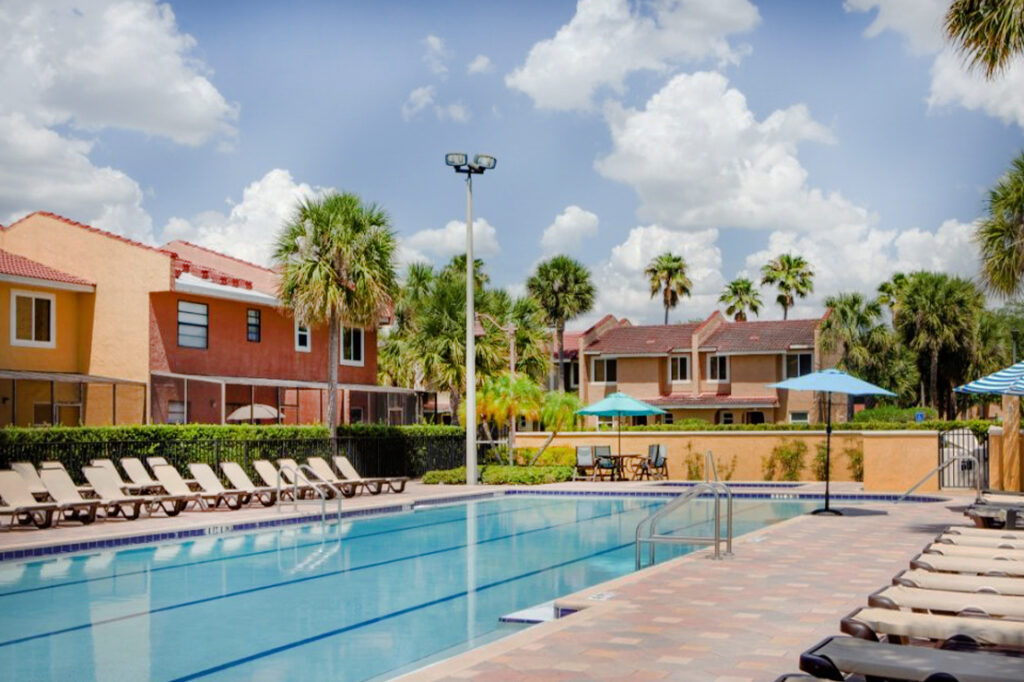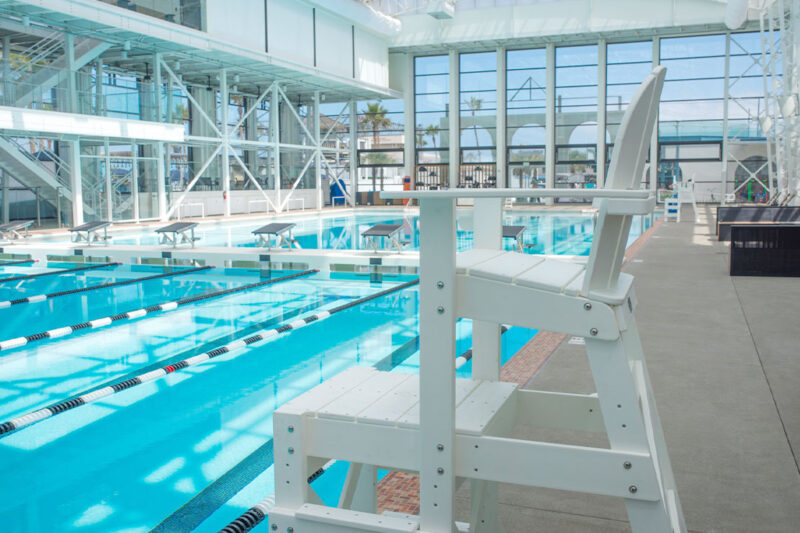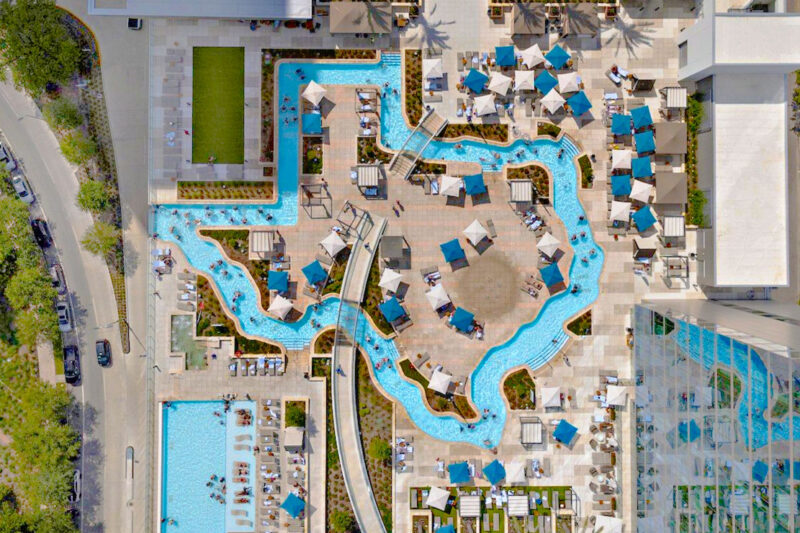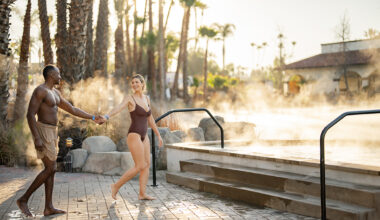
Olympic swimming pools are massive bodies of water designed for competitions. However, many hotels and recreation centers have added these pools to their property. But what does it mean to have an Olympic-sized pool?
World Aquatics, the international governing body for aquatic sports (formerly FINA), requires specific measurements and criteria for actual Olympic pools. While you may see an apartment or facility advertising its Olympic-sized pool, it may just be large.
We’re diving into the world of Olympic swimming pools and exploring their exact specifications and how they’ve evolved over time. Understanding the design of these pools for the Olympic Games will give you a new appreciation for these aquatic wonders.
How Big Is an Olympic-Sized Pool?
Size matters when it comes to Olympic-sized pools. The dimensions of this style of pool have been precisely defined. Olympic swimming pools must be the same to ensure fair competition and that record-keeping is consistent across all Olympic Games and international swimming events.
While the casual swimmer may not care if a pool is the right size, athletes need exact specifications. We’re going to break down the precise measurements of an Olympic-sized pool and explore why specific dimensions are crucial for competitive swimming.
Length
An Olympic swimming pool is 50 meters long, or approximately 164 feet. For perspective, the length of an Olympic pool is roughly the same as the width of a standard football field.
There is a small allowance for touch pads at both ends of the pool. These pads are electronic timing devices that accurately record every swimmer’s times down to the millisecond. If you’ve ever watched an Olympic race, you know how close they can be.
World Aquatics allows the maximum length of an Olympic pool to be 50.030 to account for these pads. No matter the Olympic swimming event—freestyle, backstroke, butterfly, or distance—the pool is the same length.

Width
There are no strict rules when it comes to the width dimensions of Olympic pools. The width isn’t arbitrary, though, because there are specifications for the width of each lane. The number of lanes determines the width of the pool.
Typically, an Olympic pool has 10 lanes, but this is not a mandatory requirement. The number of lanes can vary depending on the competition or facility, but 10 lanes have become the standard for the Olympic Games and major international events.
This number allows for eight lanes to be used for competition. The two outside lanes serve as buffers to minimize the impact of the turbulence on the swimmers.
World Aquatics stipulates that each lane must be at least 2.5 meters (about 8.2 feet) wide. This size ensures swimmers have enough space to compete without interfering with adjacent competitors. The lane width also helps reduce the impact of water turbulence created by neighboring swimmers.
The total width of a standard Olympic swimming pool is often 25 meters or approximately 82 feet. This width leaves enough space for competition and for equipment along the pool’s edges.
While this is the common width, some facilities may opt for wider pools for additional lanes or provide more space for warm-up areas. The width flexibility allows facilities to make certain adjustments while maintaining the integrity of competitive swimming standards.
Depth
The depth of the pool can have a significant impact on the swimmers during a competition. However, the depth is not strictly standardized and can vary.
The World Aquatics recommends a depth of 3 meters (about 9.8 feet) and no shallower than 2 meters (approximately 6.5 feet). However, they recommend pools be at least 2.5 meters (8.2 feet) for optimal conditions. The Olympic swimming pool for the Paris Olympic Games was 2.15 meters.
The depth helps minimize the effect of waves and turbulence created by the swimmers. Pools on the shallower end typically have slower competition times. There were fewer world records broken at the Paris Games than there were for the two previous Summer Olympics, which had deeper pools.
The depth requirements of Olympic pools for other competitions, such as diving, are significantly different. Diving pools are much deeper to ensure the safety of the athletes. All diving pools must be at least 5 meters (about 16 feet).
There are some facilities with varying depths to accommodate diving. However, modern competition pools often maintain a consistent depth throughout to provide uniform conditions for all swimmers.

How Much Water Is in an Olympic Swimming Pool?
There is no official requirement for how much water has to be in an Olympic swimming pool. The amount of water is dictated by the dimensions and depth of the pool, which we know can vary. However, based on the standard dimensions and depth, we can get an approximate number of gallons of water.
An Olympic pool that is 50 meters long with a minimum depth of 2 meters can hold an impressive 660,000 gallons of water. This volume of water could fill nearly 20 average-sized home swimming pools. The amount of water is even more for deeper pools.
While the volume of water isn’t regulated, the water temperature in Olympic pools is carefully controlled. No matter the pool size, they are maintained between 25 and 28 degrees Celsius (77 to 82.4 degrees Fahrenheit).
This temperature range is considered optimal for competitive swimming. It’s a comfortable temperature without being too warm, which could lead to overheating.
Are There Other Sports Swimming Pool Sizes?
There are other pool sizes besides Olympic-sized swimming pools used for various aquatic sports and levels of competitive swimming. Each pool has specific dimensions and requirements for different activities and skill levels.
Short Course Pools
Many competitive swimming events are in short-course pools, especially at the national and regional levels. These pools are typically 25 meters or 25 yards in length. Short course pools mean swimmers make more turns during races, making competitions more exciting. There are different racing strategies compared to long-course events.

Diving Pools
As we mentioned, diving requires specialized deep pools. These pools are usually 5 meters (16.4 feet) deep under the diving boards or platforms. The length and width of these pools are generally smaller than those of standard swimming pools.
Water Polo Pools
Water polo matches require a specific pool setup for men and women. The standard size for international competitions is 30 meters long by 20 meters wide for men, with a minimum depth of 2 meters. They have to be 25 meters long by 20 meters wide and at least 1.8 meters deep for women. However, there’s some flexibility in these dimensions for different levels of competition.
Artistic Swimming Pools
Artistic swimming, or synchronized swimming, needs pools that are deep enough for underwater movements. The ideal depth is at least 3 meters, with a minimum pool size of 25 meters by 20 meters for competitions.
Multi-Purpose Pools
Some aquatic facilities have pools with movable bulkheads. This feature allows them to adjust the pool length to accommodate different types of competitive swimming competitions. This flexibility makes it possible to host a variety of competitions in a single venue.
What Is the Cost of an Olympic Swimming Pool?
The cost of constructing an Olympic-sized swimming pool can vary significantly. The total cost depends on factors such as location, materials, design, and any additional features. A standard Olympic-sized pool (50 meters x 25 meters) can start anywhere from $300,000 to $500,000.
This price just covers the essentials, such as excavation, the pool shell, basic plumbing, and minimal deck area. It’s more of a starting point than the final total cost. Most Olympic pools require significantly more money due to additional features and requirements.
High-quality filtration systems, heating, lighting, starting blocks, lane lines, and timing systems can rack the costs up substantially. It can be well over $1 million when the project is all said and done.
Building an Olympic-size pool also means creating the surrounding facility. It may include locker rooms, seating areas, and other amenities, which can dramatically increase the cost of the overall project. These facilities can be millions by the time they are completed.
Olympic-Sized Pools
Many hotels and aquatic centers have invested in Olympic-sized pools for guests to enjoy, so you don’t have to be an athlete to swim like one. ResortPass can grant you access to some of these incredible pools.







